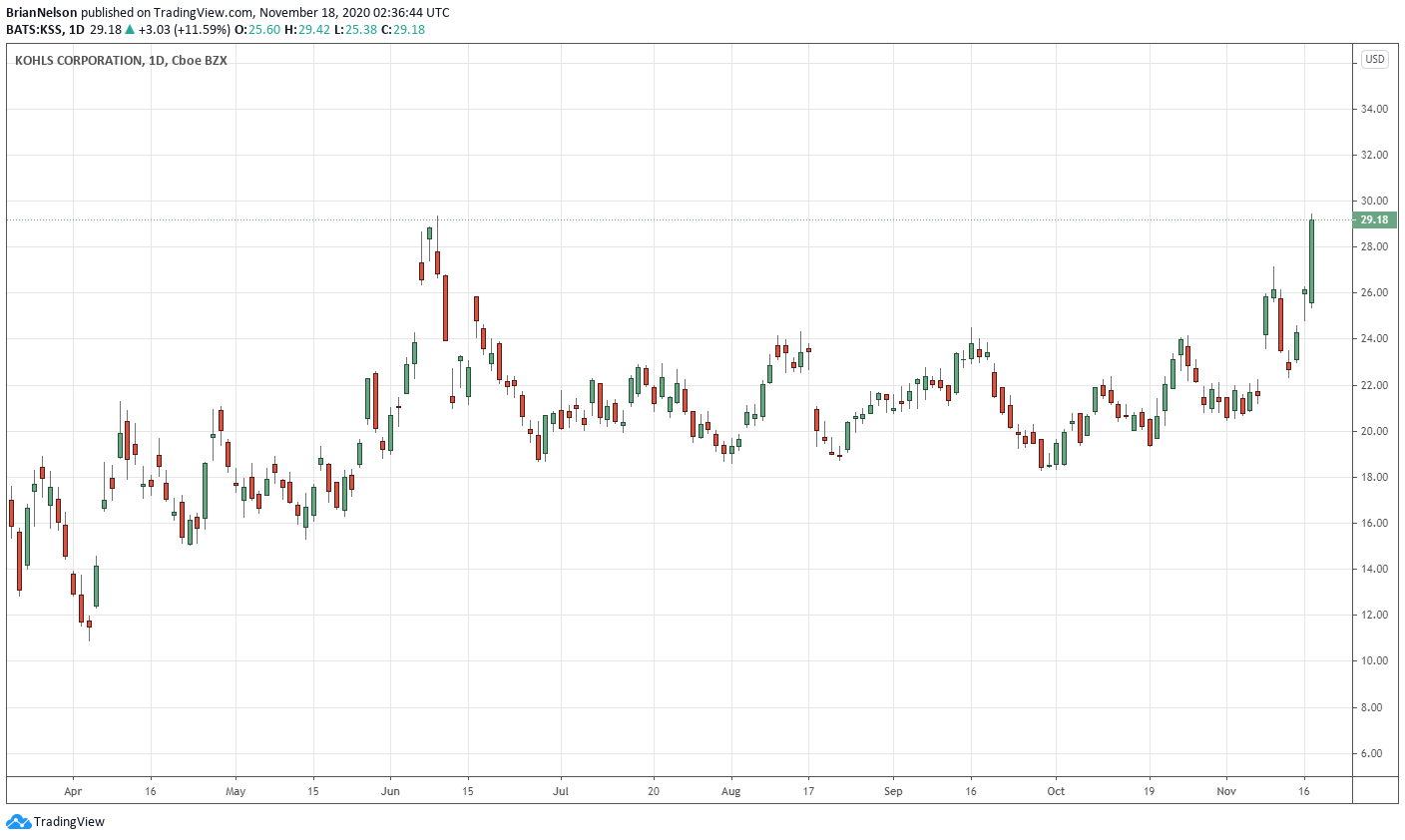Kohl’s Dead Cat Bounce May Still Have Legs

Image: Kohl's is breaking out of a month-long base on better-than-expected financial health and expectations that it will reinstate its dividend next year.
By Brian Nelson, CFA
The list of defunct department stores in the United States is a long one. The proliferation of e-commerce accelerated by the outbreak of the COVID-19 pandemic may have all but sealed the fate of many big box department stores that had already been struggling for years. Consumers want quality, price and convenience, and getting what they need with the click of a button on the Internet means those with sprawling real estate stores need to excel at digital initiatives, omnichannel strategies, and rightsizing their footprints--or they'll perish like so many have before them.
The Bon-Ton Stores (owner of Carson’s and Bergner’s) filed for bankruptcy in February 2018, Sears Holdings filed for bankruptcy in October 2018, Barneys New York filed for bankruptcy in August 2019, and just this May, J.C. Penney and Neiman Marcus filed for bankruptcy. Toys “R” Us (filed in September 2017), Sports Authority (filed March 2016), and the list of big box failures goes on and on. Remember Montgomery Ward and Circuit City? The department store business is a terrible one.
Even the most talented individuals’ efforts to make things work have flopped, too. First, there was hedge fund star Eddie Lampert, once called “the next Warren Buffett,” that thought he could turn Sears around some 15 years ago. At the time, analysts were even betting that Lampert would put up Buffett-like returns of 20% per annum based on his track record up to that point. How wrong those forecasts have been--shares of Sears now trade for $0.18 per share at last check. They had once traded over $140 per share in April 2007.
Then, there’s the story of Ron Johnson, a former Target (TGT) and Apple (AAPL) executive, who tried to save J.C. Penney from its inevitable demise. Hired as CEO of J.C. Penney in late 2011, Johnson’s strategy focused on ending the reliance on couponing and turning J.C. Penney into a store-within-a-store concept. It didn’t work. Customers left J.C. Penney in droves, and the company’s stock price was pretty much cut in half during his short tenure, removed as CEO less than two years after he took the helm. In November 2011, shares of J.C. Penney traded for ~$30 each; now, they are priced at less than $0.25.
News of the Pfizer (PFE)/BioNTech (BNTX) and Moderna (MRNA) vaccines have started to breathe some life into the shares of some of the most beaten down department stores and mall-based retail, more generally. Kohl’s (KSS) chart, in particular, is breaking out of a multi-month base that it had been forming since the COVID-19 market collapse in April. Shares of Kohl's have been cut in half year-to-date, even after the move during the trading session November 17, so there could more left to its “dead cat bounce” following its third-quarter report, which wasn’t exactly terrible.
During the quarter ending October 31, 2020, Kohl’s beat on both the top and bottom lines, and while third-quarter comparable store sales fell 13.3%, the large drop wasn’t necessarily unexpected given COVID-19. Importantly, cash flow from operations held up fairly well, coming in at $910 million during the first nine months of the year, down modestly from the $1.05 billion in the prior-year period. Kohl’s has cut capital expenditures considerably so far in 2020, with free cash flow (as measured by cash flow from operations less all capital spending) ballooning to $646 million, up 76% from $367 million over the comparable nine-month period.
We wouldn’t classify Kohl’s free cash flow generation as high quality (given the revenue declines and capital spending cuts), but the numbers could have been much worse. Kohl’s balance sheet isn’t that bad either, with the firm ending the third quarter of the year with long-term debt of $2.45 billion and cash and cash equivalents of $1.94 billion (so it has decent liquidity). The company does hold ~$2.8 billion in operating leases on the books, so lease-adjusted leverage is elevated. As with its peers Nordstrom (JWN) and Macy’s (M), Kohl’s has suspended its dividend to shore up much needed cash, but it plans to reinstate its dividend during the first half of next year.
Concluding Thoughts
The department store industry may be as poor as the airline business these days, but Kohl’s is managing to navigate the pandemic fairly well, even as it fights an uphill battle against e-commerce proliferation. The company’s annualized cash flow from operations, for example, is trending sufficiently above what we would consider normalized annual capital expenditures (~$700-$750 million).
This suggests Kohl’s can be meaningfully free cash flow positive, even under a scenario where it can invest heavily in its business during “normal” times. Management even plans to start paying a dividend again during the first half of next year, and if existing trends hold and the holiday season is a success, a reinstated payout appears achievable, in our view.
That said, however, in light of the poor backdrop of the department store business model and the preponderance of historical bankruptcies across the industry, we don’t view Kohl’s as a long-term investment idea by any stretch. Still, the stock’s technical breakout coupled with a better-than-expected financial position means its “dead cat bounce” could still have legs.
---
Related: DDS, BKE, DBI, EXPR, PLCE, GES, ROST, ZUMZ, AEO, GPS, URBN, GIII, CHS, SCVL, TJX, BURL, LB, JCP, JCPNQ, SHLD, SHLDQ
Valuentum members have access to our 16-page stock reports, Valuentum Buying Index ratings, Dividend Cushion ratios, fair value estimates and ranges, dividend reports and more. Not a member? Subscribe today. The first 14 days are free.
Brian Nelson owns shares in SPY, SCHG, DIA, VOT, and QQQ. Some of the other securities written about in this article may be included in Valuentum's simulated newsletter portfolios. Contact Valuentum for more information about its editorial policies.
0 Comments Posted Leave a comment